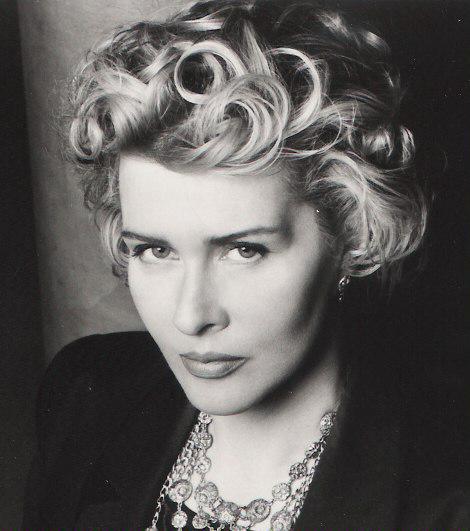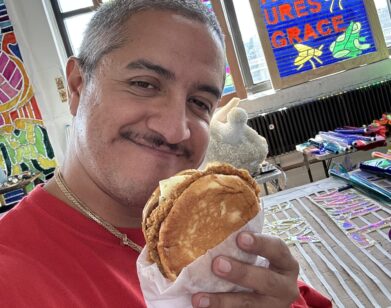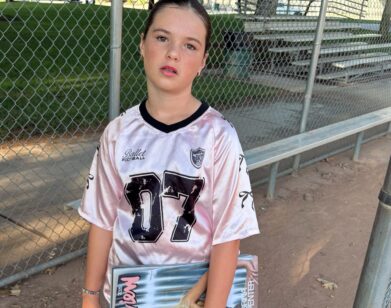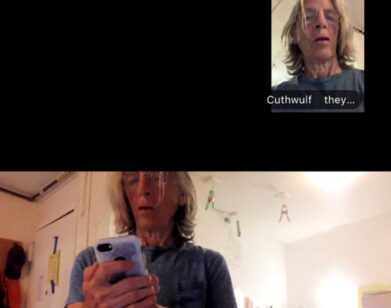Tere Tereba Finds the Devils in the City of Angels

Andy Warhol once described Tere Tereba as “looking like Hedy Lamarr and acting like Lucille Ball,” but perhaps a more appropriate comparison these days would be to glamorous cartoon reporter Brenda Starr. Though Tereba is known for her revolutionary work as a fashion designer, it’s her journalistic sensibilities that have been turning heads of late—today marks the release of her first book, Mickey Cohen: The Life and Times of LA’s Notorious Mobster, in which she unspools a gripping yarn about the life and times of the 20th-century Los Angeles underworld. She pulls off her debut effort with such literary aplomb that it comes as no surprise to learn Tereba has had a fair deal of practice over the years; as a matter of fact, much of this experience comes by way of conducting interviews for Interview. We recently visited Tereba at her Los Angeles home to talk about Marty Scorsese, Mickey Cohen, and her overall history of literary muckraking.
KEELY WEISS: It’s so nice to meet you.
TERE TEREBA: Did you have any trouble parking here? The garage is so small.
WEISS: No, no trouble at all. Your house is gorgeous—have you always lived in LA? I know you were friends with Andy Warhol, so you must have lived in New York for a while.
TEREBA: Well, I was the Los Angeles connection for Andy. I met him in Los Angeles—for many years I was bicoastal, but I’ve lived in Los Angeles for the majority of my life since I was twelve years old.
WEISS: Then around what time did you start working with Andy?
TEREBA: I was a teenager. I actually was beginning to be a fashion designer. I met him at a screening here in LA and it was at a screening room and I came in with my older friends, Jim and Pam Morrison, and the screening was only for about 14 people and Andy was in town and he had an entourage and then I was with them, and so of course he had known Jim and was interested and fascinated by him. And that’s how I got to know Andy in the beginning, I met him in that way. And then he invited me to go the next day to the MGM lot, and that was my first experience. I was just beginning to be a fashion designer; I was working an apprenticeship in a back room at that point, I wasn’t a designer yet. I was very soon a designer.
WEISS: And right around that time you made Andy Warhol’s Bad, didn’t you?
TEREBA: Yeah. All those things fell together very quickly. I was very fortunate because I became a designer and became successful as a designer very quickly, and right around then I began going into New York all the time, so I would see Andy and have all these different experiences with the group of people around him, and then I started doing interviews with Interview.
WEISS: Right, I know you’ve interviewed Spielberg and Scorsese.
TEREBA: Right, we interviewed Steven Spielberg, whom we were assigned to interview. Then we interviewed Marty Scorsese, which was a great thrill because it was a three-day interview and he showed us Taxi Driver, and then—Andy never lost the tapes, but he lost the tapes and found them ten years later!
WEISS: That must have been a trip.
TEREBA: Well, I remember running into Marty Scorsese at a restaurant four or five years later, and I remember that after he’d been so friendly he was suddenly chilly. Nobody really realized that the interview hadn’t come out; it sort of faded from memory—we were busy with other things and had moved on. But Marty Scorsese realized the interview hadn’t come out, and he of course thought it was a slight.
WEISS: When Andy found the tapes, didn’t he run the interview?
TEREBA: Well, he should have, actually. I don’t think he knew what to do with it.
WEISS: How did your writing for Interview come about?
TEREBA: Well, I was already writing but I was a fashion designer so I would do an occasional interview, essentially, when I found somebody I was interested in interviewing. I had to find a person that interested me and they would say “Let’s see” and that would happen that way, so it wasn’t a particularly consuming job for me. It was sort of like my book. I knew I could do a book, and I wanted to do a big book that could keep me interested, and it took me years to find the right subject.
WEISS: That’s actually something that I wanted to ask you. How did you decide you wanted to write a book about Mickey Cohen?
TEREBA: Well, it’s not only about Mickey Cohen. It’s about the entire LA underworld, from Prohibition to 1976. I needed to be motivated to keep my enthusiasm up for the entire time I was writing this complex book, and I’d never found a subject until this that would do that. The LA underworld had been largely unexposed—there’d been books, but they had never done what needed to be done—so I worked on this for ten years. It’s a really in-depth panoramic view of Hollywood and the underworld from the very early days; Mickey Cohen was from LA, so he is the homegrown mobster. You know, he’s charismatic, he’s outrageous, he’s dangerous, and there’s no movie gangster that was ever as exciting as this man.
WEISS: It’s interesting to hear you say that this book took ten years to write, because that’s an incredibly long time, but this book really is very intricate.
TEREBA: Well, Mickey’s a great protagonist. Through Mickey, who’s here from age two, you get the whole scope from Prohibition to 1976. So the ten years was needed because no one had really focused on the LA underworld, and given their collusion with the politicians and police departments of the city, it takes a lot of digging to get this panoramic story that covers 60 years. So I was thrilled by it because every minute of it was fascinating to me, and I unearthed more and more fascinating stories and people. You’ve got stars like Frank Sinatra, Judy Garland, and Lana Turner, in whose bedroom one of Mickey Cohen’s men was murdered.
WEISS: Didn’t her daughter take the rap for that murder?
TEREBA: Sure, but nobody really knew who had done it. Johnny Stampanato, I was really able to uncover—he was never particularly known, much about him, and I give more than anybody ever has on that subject too. I cover his story in my book, but even though he was a big deal in all the papers, nobody ever did more than write a few lines about his being a Mickey Cohen mobster. His criminal history, he had no convictions and a very slim arrest record, but I found out a lot about him and how he functioned.
WEISS: It seems like there’s a lot of new ground in your book.
TEREBA: Yeah, there is. Another thing is I have all these rare documents, like from the Senate committee where Mickey Cohen was testifying, I have the actual depositions. I have actual FBI files and crime commission files and different photographs of rare documents and rare photos that illustrate all the people who were maybe photographed once; many of these photos had never been published before. I have a photo of—there’s this famous socialite who was the leading light of café society, the Countess di Frasso, who was like an Edith Wharton figure, and she fell in love with Bugsy Siegel. She had had a very big affair with Gary Cooper and a short-lived affair with Clark Gable, and she was eighteen years older than Siegel, so she sort of became his mentor too, and she introduced him to high society. That’s another thing, this society angle: no one had any idea that Busy Siegel, who was in his early 20s, was the person who had allowed for the Luciano-Costello-Lansky-Siegel gang to become the preeminent force of organized crime.
WEISS: As a matter of fact, there’s this great phrase that you use the book when you describe the gangster world Mickey was looking up to when he was still a boxer, back when Lucky Luciano and the like were in charge. You used this phrase “muscle and moxie”—”The Italians were the muscle…”
TEREBA: “The Jews were the moxie, and they split the money between them.” That’s the combination. See, people think of the mob as Italians. Well, during the golden era of syndicated crime it was a combination of Jews and Italians and other people as well, which you see in Boardwalk Empire. Muscle, moxie, and money, the three Ms.
MICKEY COHEN: THE LIFE AND TIMES OF LA’S NOTORIOUS MOBSTER IS OUT NOW.






